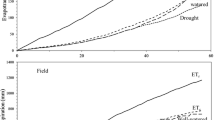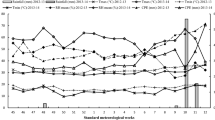Abstract
Different thermal-based plant feedback systems have been used for irrigation management of cotton and grain crops in the Texas High Plains region, producing yields that are similar or better than irrigation scheduling using the neutron probe. However, there are limited studies using plant feedback systems to actively scheduling irrigations for corn. In this 2-year study, a drought tolerant and a conventional hybrid were managed under a variable rate center pivot irrigation system. The main treatments were manual and plant feedback irrigation scheduling based on weekly neutron probe readings and an integrated crop water stress index (CWSI), respectively. In each main treatment, three irrigation treatment levels were established. Crop responses were compared between irrigation methods and levels. Results demonstrated that overall grain and biomass yields and grain WUE for the plant feedback-control plots were similar to those from the manual-control plots for both years. These results indicate that a plant feedback system using a CWSI could be used to manage corn in a semi-arid region and over a large-sized field. The plant feedback system could provide convenience and time savings to farmers who manage multiple center pivot fields.







Similar content being viewed by others
Notes
The mention of trade names, commercial products or companies in this publication is solely for the purpose of providing specific information and does not imply recommendation or endorsement by the U.S. Department of Agriculture.
References
Allen RG, Pereira LS, Raes D, Smith D (1998) Crop evapotranspiration-Guidelines for computing crop water requirements-FAO Irrigation and drainage paper 56. Rome
ASCE (2005) The ASCE standardized reference evapotranspiration equation. Report by the American Society of Civil Engineers (ASCE) Task Committee on Standardization of Reference Evapotranspiration. In: Allen RG, Walter IA, Elliot RI, Howell TA, Henfisu D, Jensen ME, Snyder RL (eds) ADCE, Reston
Ben-Gal A, Agam N, Alchanatis V, Cohen Y, Yermiyahu U, Zipori I, Presnov E, Sprintsin M, Arnon Dag (2009) Evaluating water stress in irrigated olives: correlation of soil water status, tree water status, and thermal imagery. Irrig Sci 27:367–376
Borrás L, Westgate ME, Otegui ME (2003) Control of kernel weight and kernel water relations by post-flowering source-sink ration in maize. Ann Bot 91:857–867
Burke JJ, Mahan JR, Hatfield JL (1988) Crop specific thermal kinetic windows in relation to wheat and cotton biomass production. Agron J 80:553–556
Cakir R (2004) Effect of water stress at different development stages on vegetative and reproductive growth of corn. Field Crops Res 89:1–16
Claassen MM, Shaw RH (1970) Water deficit effects on corn II. Grain components. Agron J 62:652–655
Colaizzi PD, Barnes EM, Clarke TR, Choi CY, Waller PM, Haberland J, Kostrzewski M (2003a) Water stress detection under high frequency sprinkler irrigation with water deficit index. J Irrig Drain Eng 129(1):36–43
Colaizzi PD, Barnes EM, Clarke TR, Choi CY, Waller PM (2003b) Estimating soil moisture under low-frequency surface irrigation using crop water stress index. J Irrig Drain Eng 129(1):27–35
Colaizzi PD, Evett SR, Agam N, Schwartz RC, Kustas WP, Cosh MH, McKee L (2016) Soil heat flux calculation for sunlit and shaded surfaces under row crops: 2. Model test. Agric For Meteorol 216:129–140
DeJonge KC, Taghvaeian S, Trout TT, Comas LH (2015) Comparison of canopy temperature-based water stress indices for maize. Agric Water Manag 156:51–62
DeLoughery RL, Crookston RK (1979) Harvest index of corn affected by population density, maturity rating, and environment. Agron J 71(4):577–580
Echarte L, Andrade LH (2003) Harvest index stability of Argentinean maize hybrids released between 1965 and 1993. Field Crops Res 82:1–12
Evett SR (2003) Measuring soil water by neutron thermalization. In: Stewart BA, Howell TA (eds) Encyclopedia of water science. Marcel Dekker, Inc., New York, pp 889–893
Evett SR (2008) Chapter 3: Neutron moisture meters. In: Evett SR, Heng LK, Moutonnet P, Nguyen ML (eds) Field estimation of soil water content: a practical guide to methods, instrumentation, and sensor technology. AEA-TCS-30. International Atomic Energy Agency, Vienna, pp 39–54. http://www-pub.iaea.org/books/iaeabooks/7978/Field-Estimation-of-Soil-Water-Content
Evett SR, Howell TA, Schneider AD, Upchurch DR, Wanjura DF (1996) Canopy temperature based automatic irrigation control. In: Camp CR, Sadler EJ, Yoder RE (eds) Proceedings international conference evapotranspiration and irrigation scheduling. ASAE, St. Joseph, Mich, pp 207–213
Hall AJ, Richards RA (2013) Prognosis for genetic improvement of yield potential and water-limited yield of major crops. Field Crops Res 143:18–23
Hall AJ, Vicella F, Trapani N, Chimenti C (1982) The effects of water stress and genotype on the dynamics of pollen-shedding and silking in maize. Field Crop Res 5:349–363
Hao B, Xue Q, Marek TH, Jessup KE, Becker J, Hou X, Xu W, Bynum ED, Bean BW, Colaizzi PD, Howell TA (2015) Water use and grain yield in drought-tolerant corn in the Texas High Plains. Agron J 107(5):1922–1930
Howell TA (2001) Enhancing water use efficiency in irrigated agriculture. Agron J 93(2):281
Howell TA, Copeland KS, Schneider AD, Dusek DA (1989) Sprinkler irrigation management for corn—southern great plains. Trans ASAE 32(1):147–155
Howell TA, Tolk JA, Schneider AD, Evett SR (1998) Evapotranspiration, yield, and water use efficiency of corn hybrids differing in maturity. Agron J 90(1):3–9
Howell TA, Schneider AD, Dusek DA (2002) Effects of furrow diking on corn response to limited and full sprinkler irrigation. Soil Sci Soc Am J 66:222–227
Hsiao TC, Acevedo E (1974) Plant responses to water deficits, water-use efficiency, and drought resistance. Agric Meteorol 14:59–84
Hugh E, Hugh J, Richard F (2003) Effect of drought stress on leaf and whole canopy radiation use efficiency and yield of maize. Agron J 95(3):688–696
Humes KS, Kustas WP, Moran MS, Nichols WD, Weltz MA (1994) Variability of emissivity and surface temperature over a sparsely vegetated surface. Water Res Res 30(5):1299–1310
Irmak S, Haman DZ, Bastug R (2000) determination of crop water stress index for irrigation timing and yield estimation of corn. Agron J 92:1221–1227
Jackson RD (1982) Canopy temperature and crop water stress. In: Hillel D (ed) Advances in irrigation, vol 1. Academic, New York, pp 43–85
Jackson RD, Idso SB, Reginato RJ, Pinter PJ Jr (1981) Canopy temperature as a crop water stress indicator. Water Resour Res 17(4):1133–1138
Jackson RD, Kustas WP, Choudhury BJ (1988) A reexamination of the crop water stress index. Irrig Sci 9:309–317
Klocke NL, Currie RS, Tomsicek DJ, Koehn J (2011) Corn yield response to deficit irrigation. Trans ASABE 54(3):931–940
Klocke NL, Currie RS, Kisekka I, Stone LR (2014) Corn and grain sorghum response to limited irrigation, drought, and hail. Appl Eng Agric 30(6):915–924
Littell RC, Milliken GA, Stroup WW, Wolfinger RD, Schabenberger O (2006) Multi-factor treatment designs with multiple error terms in SAS for Mixed models. SAS Institute, Cary, North Carolina
Mounce RB, O’Shaughnessy SA, Blaser BC, Colaizzi PD, Evett SR (2016) Crop response of drought-tolerant and conventional maize hybrids in a semiarid environment. Irrig Sci 34(3):231–244
O’Shaughnessy SA, Evett SR (2010) Canopy temperature based system effectively schedules and controls center pivot irrigation for cotton. Agric Water Manag 97:1310–1316
O’Shaughnessy SA, Hebel MA, Evett SR, Colaizzi PD (2011) Evaluation of a wireless infrared thermometer with a narrow field of view. Comput Electron Agric 76:59–68
O’Shaughnessy SA, Evett S, Colaizzi P, Howell TA (2012a) Grain sorghum response to irrigation scheduling with the time-temperature threshold method and deficit irrigation levels. Trans ASABE 55(2):451–461
O’Shaughnessy SA, Evett SR, Colaizzi PD, Howell TA (2012b) A crop water stress index and time threshold for automatic irrigation scheduling of grain sorghum. Agric Water Manag 107:122–132
O’Shaughnessy SA, Urrego YF, Evett SR, Colaizzi PD, Howell TA (2013) Assessing application uniformity of a variable rate irrigation system in a windy location. Appl Eng Agric 29(4):497–510
O’Shaughnessy SA, Evett SR, Colaizzi PD, Tolk JA, Howell TA (2014) Early and late maturing grain sorghum under variable climatic conditions in the Texas High Plains. Trans ASABE 57(6):1583–1594
O’Shaughnessy SA, Evett SR, Colaizzi PD (2015) Dynamic prescription maps for site-specific variable rate irrigation of cotton. Agric Water Manag 159:123–138
Osroosh Y, Peters RT, Campbell CS, Zhang Q (2015) Automatic irrigation scheduling of apple trees using theoretical crop water stress index with an innovative dynamic threshold. Comput Electron Agric 118:193–203
Osroosh Y, Peters RT, Campbell CS (2016) Daylight crop water stress index for continuous monitoring of water status in apple trees. Irrig Sci 34(3):209–219
Peters RT, Evett SR (2004) Modeling diurnal canopy temperature dynamics using one-time-of-day measurements and a reference temperature curve. Agron J 96(6):1553–1561
Peters RT, Evett SR (2008) Automation of a center pivot using the temperature-time-threshold method of irrigation scheduling. J Irrig Drain Eng 134(3):286–291
Scanlon BR, Faunt CC, Longuevergne L, Reddy RC, Alley WM, McGuire VL, McMahon PB (2012) Groundwater depletion and sustainability of irrigation in the US High Plains and Central Valley. In: Proc Natl. Acad Sci USA, pp 9320–9932
Sinclair TR (1998) Historical changes in harvest index and crop nitrogen accumulation. Crop Sci 38(3):638
Soil Survey Staff (2004) National soil survey characterization data. Soil Survey Laboratory, National Soil Survey Center, USDA-NRCS - Lincoln, NE
Taghvaeian S, Chávez JL, Hansen NC (2012) Infrared thermometry to estimate crop water stress index and water use of irrigated maize in northeastern Colorado. Remote Sens 4:3619–3637
Tolk JA, Evett SR, Schwartz RC (2015) Field-measured, hourly soil water evaporation stages in relation to reference evapotranspiration rate and soil to air temperature ratio. Vadose Zone J. doi:10.2136/vzj2014.07.0079
Unkovich M, Baldock J, Forbes M (2010) Chapter 5—variability in harvest index of grain crops and potential significance for carbon accounting: examples from Australian agriculture. Adv Agron 105:173–219
Upchurch DR, Wanjura DF, Burke JJ, Mahan JR (1996) Biologically identified optimal temperature interactive console (BIOTIC) for managing irrigation. U.S. patent No. 5,539,637
USDA ERS (2016) http://www.ers.usda.gov/topics/crops/corn.aspx. Accessed 29 July 2016
USDA NASS (2016) https://quickstats.nass.usda.gov/. Accessed 29 July 2016
Wanjura DF, Upchurch DR, Mahan JR (1992) Automated irrigation based on threshold canopy temperature. Trans ASABE 35(1):153–159
Wanjura DF, Upchurch DR, Mahan JR (1995) Control of irrigation scheduling using temperature-time thresholds. Trans ASAE 38(2):403–409
Wanjura DF, Upchurch DR, Mahan JR (2004) Establishing differential irrigation levels using temperature-time thresholds. Appl Eng Agric 20(2):201–206
Yazar A, Howell TA, Dusek DA, Copeland KS (1999) Evaluation of crop water stress index for LEPA irrigated corn. Irrig Sci 18:171–180
Acknowledgements
The authors gratefully acknowledge CRADA (58-3K95-0-1455-M) with Valmont Industries, Inc. Valley Nebraska, the expertise of Mr. Luke Britten, Agricultural Research Technician, USDA-ARS, Bushland, TX and funding form the Ogallala Aquifer Program, a consortium between USDA-Agricultural Research Service, Kansas State University, Texas AgriLife Extension Service & Research, Texas Tech University, and West Texas A&M University.
Author information
Authors and Affiliations
Corresponding author
Additional information
Communicated by E. Fereres.
Disclaimer
The U.S. Department of Agriculture (USDA) prohibits discrimination in all its programs and activities on the basis of race, color, national origin, age, disability, and where applicable, sex, marital status, familial status, parental status, religion, sexual orientation, genetic information, political beliefs, reprisal, or because all or part of an individual’s income is derived from any public assistance program (not all prohibited bases apply to all programs). Persons with disabilities who require alternative means for communication of program information (Braille, large print, audiotape, etc.) should contact USDA’s TARGET Center at (202) 720-2600 (voice and TDD). To file a complaint of discrimination, write to USDA, Director, Office of Civil Rights, 1400 Independence Avenue, S.W., Washington, D.C. 20250-9410, or call (800) 795-3272 (voice) or (202) 720-6382 (TDD). USDA is an equal opportunity provider and employer.
Rights and permissions
About this article
Cite this article
O’Shaughnessy, S.A., Andrade, M.A. & Evett, S.R. Using an integrated crop water stress index for irrigation scheduling of two corn hybrids in a semi-arid region. Irrig Sci 35, 451–467 (2017). https://doi.org/10.1007/s00271-017-0552-x
Received:
Accepted:
Published:
Issue Date:
DOI: https://doi.org/10.1007/s00271-017-0552-x




